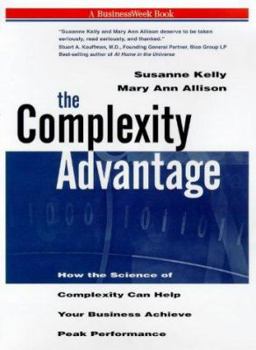The Complexity Advantage: How the Science of Complexity Can Help Your Business Achieve Peak Performance
This text provides examples from multinational businesses to show readers concrete and practical methods, based on complexity theory, for solving practical business problems. The book also seeks to... This description may be from another edition of this product.
Format:Hardcover
Language:English
ISBN:0070014000
ISBN13:9780070014008
Release Date:January 1999
Publisher:McGraw-Hill Companies
Length:261 Pages
Weight:1.70 lbs.
Dimensions:1.1" x 6.3" x 9.3"
Customer Reviews
5 ratings
"The best business plan is only a best guess"
Published by Thriftbooks.com User , 24 years ago
"Your business comprises self-organizing systems whether you know it or like it. You can cut costs and improve profits dramatically by learning to work with these systems rather than against them. So, what is self-organization and how does it work?...In this book," Susanne Kelly and Mary Ann Allison write, "we build on complexity science to explain and apply the principles of self-organization to business and organizational behavior. We discuss the enterprise environment and energy that leaders must provide to generate the power and precision of laser-sharp business performance"(p.4).In this context, in Chapter 1, after defining complexity science and complexity advantage, they argue that "Complexity advantage companies address today's transition in business-plagued by rapid change and increasing uncertainty. For approximately a century our manufacturing model was comparatively stable...The Information Age has turned previous 'knowns' upside-down...The best business plan is only a best guess." And hence they summarize the old and new business paradigms as following:I. Manufacturing Age Business* Game: Bulk-material manufacturing.* Goal: Commodity product.* Domain: Regional.* Future: Predictability, deterministic.* Change Periodic nuance, steady rate, digestable.* Rules: Linear cause and effect.* Game plan:Five-year strategic plans.* Leader: Manages strategic plan to end state.* Ownership: Centralized decision-making and responsibility.* Challenge: Demand versus capacity to deliver.* Resources: Material and financial capital.* Risk: Moving too quickly-out of control.* Approach: Quality, low cost of production. Branding, emergent price standards. Diminishing returns.* Role of Team: Optimizing of quality and productivity. Application of raw energy. Repetitive day-to-day operations. Processing of resources.* Process Perspective: Parts interact in sequence of steps. End-to-end effiency key, standardization the answer.II. Information Age Business* Game: Design and use of technology.* Goal: Knowledge-based products.* Domain: Global.* Future: Uncertainty, probability, possibility.* Change: Way of life - accelerating, overwhelming.* Rules: Nonlinear complex interaction.* Game Plan: Three-year probability scenarios.* Leader: Envisions and coaches on direction.* Ownership: Distributed decision-making and responsibility.* Challenge: Demand versus capacity for change.* Resources: Human, social, or intellectual capital.* Risk: Moving too slowly-out of the running.* Approach: Be first-best if possible, high-cost R & D. Market lock-on, high margins. Increasing returns.* Role of Team: Quality:productivity:adaptability. Application of ideas. Quest for innovation. Processing of information.* Process Perspective: Whole emerges from interacting parts. Micro-to macrointegrity key, feedback the answer. Finally, they write that "By the way, if you are part of a start-up or a small-to-medium-sized business, don't be fooled by the adjective global. Today, satellite com
The winners are adaptive creatures of these chaotic times.
Published by Thriftbooks.com User , 26 years ago
Based on experience using complexity theory in working to promote organizational change relating to process, software, architecture, and organizational behavior, Kelly arrived at important insights that she and Allison present in this informative and absorbing work. They build on complexity science to explain and apply the principles of self-organization to business and organizational behavior. They describe what they refer to as "complexity advantage companies" capable of changing in response to the highly chaotic, unpredictable environment of today's markets. They introduce a model for organizational evolutionary fitness (the complexity advantage model) which has its origins in the Capability Maturity Model used to develop software. The insights and creativity of the authors make this an impressive book.
KEEP THIS BOOK ON YOUR DESK
Published by Thriftbooks.com User , 26 years ago
THIS IS A GOOD BOOK. WE KEEP A COPY ON OUR DESK TO REFER TO IT OFTEN. WE FOUND IT INTERESTING AND ENJOYABLE, AND EVEN LEARNED SOMETHINGS FROM IT. IN OUR DISTRIBUTION COMPANY WE TRY TO OVER COME STALLS WHICH SLOW US UP AND BRING US DOWN. WE FIND THAT THIS BOOKS KEPT US GOING. WE ALSO FOUND THE BOOK THE 2000 PERCENT SOLOUTION TO TAKE US TO THE NEXT LEVEL TO GET THROUGH THE STALLS THAT PLAGUE US ALL EVRYDAY OF OUR LIVES. BOTH ARE GOOD READING.
The science of complexity is now in our business vocabulary.
Published by Thriftbooks.com User , 26 years ago
This book takes a new and different approach to deal with the multitude of inputs and signals coming at us today. I found the science of complexity a very logical and understandable approach, and the illustration of taking diffuse light and focusing it into a laser with many times the power, a wonderful analogy. This book also tries to explain why reengineering, benchmarking and TQM have not been greater successes. The 14 Steps to Success are the core of the book and the part on which a reader should focus. I am a great believer in the need to repeat to continuously adapt and improve, and "repeat" is a critical part of the processes here also. This will become a widely read and discussed book in business in the years to come.
A thought-provoking book for anyone in business
Published by Thriftbooks.com User , 26 years ago
This is a thought provoking, perception changing book, grounded in reality, with good real-world examples. For anyone working in the fast changing world of business, it provides a practical way of moving forward and being innovative while still maintaining the integrity of the group involved. The book demonstrates how to integrate the individual contributions of people in the workplace with the needs of the organization so that both thrive. I recommend this book highly.





